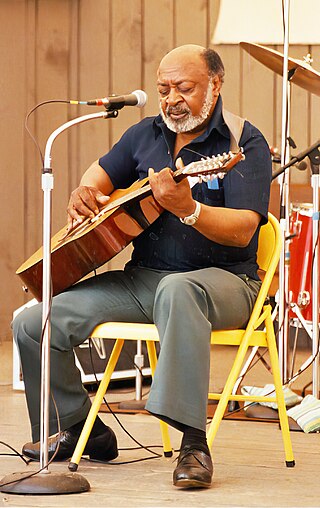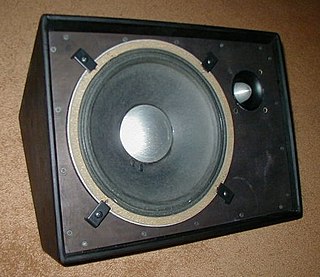Related Research Articles

A microphone, colloquially called a mic, is a transducer that converts sound into an electrical signal. Microphones are used in many applications such as telephones, hearing aids, public address systems for concert halls and public events, motion picture production, live and recorded audio engineering, sound recording, two-way radios, megaphones, and radio and television broadcasting. They are also used in computers and other electronic devices, such as mobile phones, for recording sounds, speech recognition, VoIP, and other purposes, such as ultrasonic sensors or knock sensors.

Audio feedback is a positive feedback situation that may occur when an acoustic path exists between an audio input and an audio output. In this example, a signal received by the microphone is amplified and passed out of the loudspeaker. The sound from the loudspeaker can then be received by the microphone again, amplified further, and then passed out through the loudspeaker again. The frequency of the resulting howl is determined by resonance frequencies in the microphone, amplifier, and loudspeaker, the acoustics of the room, the directional pick-up and emission patterns of the microphone and loudspeaker, and the distance between them. The principles of audio feedback were first discovered by Danish scientist Søren Absalon Larsen, hence it is also known as the Larsen effect.

Positive feedback is a process that occurs in a feedback loop which exacerbates the effects of a small disturbance. That is, the effects of a perturbation on a system include an increase in the magnitude of the perturbation. That is, A produces more of B which in turn produces more of A. In contrast, a system in which the results of a change act to reduce or counteract it has negative feedback. Both concepts play an important role in science and engineering, including biology, chemistry, and cybernetics.

Ambisonics is a full-sphere surround sound format: in addition to the horizontal plane, it covers sound sources above and below the listener.

Surround sound is a technique for enriching the fidelity and depth of sound reproduction by using multiple audio channels from speakers that surround the listener. Its first application was in movie theaters. Prior to surround sound, theater sound systems commonly had three screen channels of sound that played from three loudspeakers located in front of the audience. Surround sound adds one or more channels from loudspeakers to the side or behind the listener that are able to create the sensation of sound coming from any horizontal direction around the listener.

A hearing aid is a device designed to improve hearing by making sound audible to a person with hearing loss. Hearing aids are classified as medical devices in most countries, and regulated by the respective regulations. Small audio amplifiers such as personal sound amplification products (PSAPs) or other plain sound reinforcing systems cannot be sold as "hearing aids".

A sound reinforcement system is the combination of microphones, signal processors, amplifiers, and loudspeakers in enclosures all controlled by a mixing console that makes live or pre-recorded sounds louder and may also distribute those sounds to a larger or more distant audience. In many situations, a sound reinforcement system is also used to enhance or alter the sound of the sources on the stage, typically by using electronic effects, such as reverb, as opposed to simply amplifying the sources unaltered.
Shure Incorporated is an American audio products corporation. It was founded by Sidney N. Shure in Chicago, Illinois, in 1925 as a supplier of radio parts kits. The company became a consumer and professional audio-electronics manufacturer of microphones, wireless microphone systems, phonograph cartridges, discussion systems, mixers, and digital signal processing. The company also manufactures listening products, including headphones, high-end earphones, and personal monitor systems.

A boundary microphone is one or more small omnidirectional or cardioid condenser mic capsule(s) positioned near or flush with a boundary (surface) such as a floor, table, or wall. The capsule(s) are typically mounted in a flat plate or housing. The arrangement provides a directional half-space pickup pattern while delivering a relatively phase-coherent output signal.

The Shure SM58 is a professional cardioid dynamic microphone, commonly used in live vocal applications. Produced since 1966 by Shure Incorporated, it has built a reputation among musicians for its durability and sound, and is still the industry standard for live vocal performance microphones. The SM58 is the most popular live vocal microphone in the world. It is a development of the SM57 microphone, which is another industry standard for both live and recorded music. In both cases, SM stands for studio microphone.
The Shure SM57 is a low-impedance cardioid dynamic microphone made by Shure Incorporated and commonly used in live sound reinforcement and studio recording. It is one of the best-selling microphones in the world. It is used extensively in amplified music and has been used for speeches by every U.S. president since its introduction in 1965. In 2004, honoring its four decades of "solid, dependable performance", it was inducted into the first-ever TEC Awards TECnology Hall of Fame.
Adaptive feedback cancellation is a common method of cancelling audio feedback in a variety of electro-acoustic systems such as digital hearing aids. The time varying acoustic feedback leakage paths can only be eliminated with adaptive feedback cancellation. When an electro-acoustic system with an adaptive feedback canceller is presented with a correlated input signal, a recurrent distortion artifact, entrainment is generated. There is a difference between the system identification and feedback cancellation.

There are a number of well-developed microphone techniques used for recording musical, film, or voice sources or picking up sounds as part of sound reinforcement systems. The choice of technique depends on a number of factors, including:

The proximity effect in audio is an increase in bass or low frequency response when a sound source is close to a directional or cardioid microphone. Proximity effect is a change in the frequency response of a directional pattern microphone that results in an emphasis on lower frequencies. It is caused by the use of ports to create directional polar pickup patterns, so omni-directional microphones do not exhibit the effect

An automixer, or automatic microphone mixer, is a live sound mixing device that automatically reduces the strength of a microphone's audio signal when it is not being used. Automixers reduce extraneous noise picked up when several microphones operate simultaneously.

A stage monitor system is a set of performer-facing loudspeakers called monitor speakers, stage monitors, floor monitors, wedges, or foldbacks on stage during live music performances in which a sound reinforcement system is used to amplify a performance for the audience. The monitor system allows musicians to hear themselves and fellow band members clearly.
Stage wash in professional audio is unwanted sound entering a microphone on stage during a concert. Stage wash can come from the main public address system, from monitor loudspeakers, from instrument amplifiers such as for guitars and keyboards, and from loud instruments such as drums. The effects of stage wash in an overall mix may include a sense of muddiness and lack of detail, as other sounds modulate the desired sound. High-pass filters on mixing consoles can help reduce problems with stage wash by greatly attenuating low frequencies. Other methods of combating stage wash include using hyper-cardioid microphones, exchanging monitor loudspeakers for in-ear monitors, putting instrument amplifiers offstage or in isolation boxes, isolating drum bleed with drum glass and gobos, and employing directional methods and models in the subwoofers and main loudspeaker system.
A feedback suppressor is an audio signal processing device which is used in the signal path in a live sound reinforcement system to prevent or suppress audio feedback.

The Shure SM7 is a professional cardioid dynamic microphone, commonly used in broadcasting applications since 1973. Designed by Shure, it has been described as an "iconic" industry standard microphone for its focused, directional sound and its widespread adoption in radio, television and recording studios. In 2007–2008, the SM7B model became popular for professional podcasting.

The Electro-Voice RE20 is an American professional cardioid dynamic microphone, commonly used in broadcasting applications since 1968. Designed by Electro-Voice using the company's patented Variable-D technology and a large-diaphragm element, it has been described as an industry standard "iconic" microphone for its natural sound and its wide usage in radio, television and recording studios. In 2015, the RE20 was inducted into the TEC Awards Technology Hall of Fame.
References
- 1 2 3 "Microphone Techniques: Live Sound Reinforcement" (PDF). Shure Educational Publication. Shure. December 2007. p. 36. Archived from the original (PDF) on March 3, 2011. Retrieved May 2, 2011.
- ↑ "How-to: Miking Acoustic Instruments". Shure Notes for Houses of Worship. Shure. Archived from the original on July 22, 2011. Retrieved May 2, 2011.
Every time the number of microphones doubles, the Potential Acoustic Gain of the sound system decreases by 3 dB.
- 1 2 3 Nave, Carl R. "Rod". "Increasing Potential Acoustic Gain". HyperPhysics. Georgia State University . Retrieved May 2, 2011.
- ↑ Gary D. Davis; Ralph Jones (1989). The sound reinforcement handbook. Recording and Audio Technology (2 ed.). Hal Leonard Corporation. p. 52. ISBN 0-88188-900-8.
- ↑ Hargraves, Kent (April 28, 2011). "Lose The Feedback: Improving Gain Before Feedback in Worship". StudyHall. ProSoundWeb. Retrieved May 2, 2011.
- 1 2 Troxel, Dana (October 2005). "Understanding Acoustic Feedback & Suppressors". RaneNote. Rane Corporation. Archived from the original on May 7, 2015. Retrieved May 2, 2011.
- ↑ Valente, Michael (2002). Hearing aids: standards, options, and limitations (2 ed.). Thieme. pp. 242–243. ISBN 1-58890-103-3.